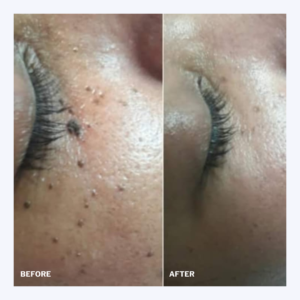The treatment you’re describing for removing moles is known as electrosurgery or electrocautery. This is a common dermatological procedure used to remove moles and other skin growths. Here’s a detailed overview:
- Procedure: Electrosurgery involves the use of a special instrument where an electric current is passed through a fine wire. The wire heats up and is used to carefully burn off the upper layers of the skin where the mole is located.
- Effectiveness: This technique is effective for removing moles, as the heat from the wire cauterizes the skin, reducing bleeding and minimizing the risk of infection. It’s often used for smaller moles and may be preferred for its precision.
- Multiple Treatments: Depending on the size and depth of the mole, more than one treatment session might be required to completely remove it.
- Pain and Recovery: The area is usually numbed with a local anesthetic before the procedure, so pain is minimal. There may be some discomfort, swelling, or redness after the treatment, but these symptoms typically subside within a few days.
- Aftercare: Post-procedure care is important to prevent infection and ensure proper healing. This may include keeping the area clean and applying an antibiotic ointment as directed by the dermatologist.
- Scarring: There is a risk of scarring with electrosurgery, although it’s generally minimal. The skill of the dermatologist and the care taken during healing can significantly influence the appearance of the treated area post-recovery.
- Considerations: Not all moles are suitable for removal via electrosurgery. Moles that are large, deeply embedded, or have irregular features may require different methods. It’s also crucial to have moles evaluated by a healthcare professional before removal, to ensure they are not cancerous or atypical.
- Benefits: Electrosurgery is a quick, relatively simple procedure and can be done in an outpatient setting, which makes it a convenient option for many patients.


Call L’essence Beauty & Spa today at (469) 412-1096 to schedule

